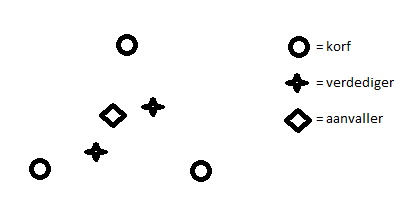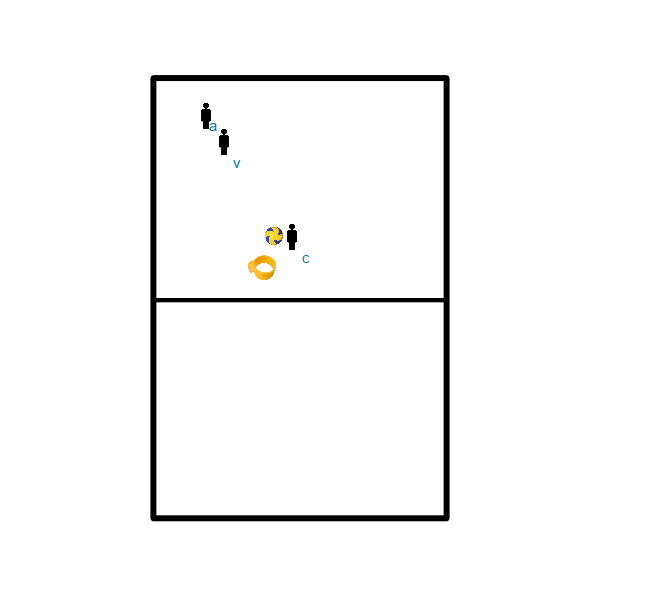Korfball drills for technique defense
- 2 in front of the basket.
- One person behind the basket tries to get in front.
- It doesn't work because someone is defending in front of the basket.
- Throw long ball. Change every 2 shots.
- Make 8
- There are 3 posts placed in a triangle, pointing to the centre of the triangle.
- The defenders try to prevent the attacker from scoring.
- Do this until the attacker has scored twice or 1 minute has passed and then turn around.

- Three teams at a basket. 1 shooter, 2 catchers who stand about 3 metres on either side of the basket facing the shooter.
- As soon as the shooter has released the ball, they may move towards the basket to catch it.
- The first player to catch the ball correctly may be the shooter.
- Quick turn.
- If there is a person who does not catch the ball first, give that person extra guidance to catch it correctly.
- You have two mats in the room, two teams have to defend each a mat of their own.
- But before they can attack, one of the two teams must complete a task. The team that finishes first gets the ball and may attack.
- The other teams may only move once their team member has also completed the task.
- You are not allowed to run with the ball, so you have to pass.
- List:
- 5 passed balls,
- 10 penalty shots,
- 5 shots from 4 meters,
- 15 walk-throughs from behind the basket,
- 5 shots from 3 meters behind the basket.
- 2 in front of the basket.
- One person behind the basket tries to get in front.
- It doesn't work because someone is defending in front of the basket.
- Throw long ball. Change every 2 shots.
- Make 8
- Per basket 4 players, 2 attackers, 2 defenders.
- They compete with each other and the rules are changed a little bit each time.
- The attackers must score 2x. Intercept the defenders 2x the ball then there is exchanged
- same as above but now there may only be shot if there is at least 1x overplayed
- same as 1 but only allowed to score with an extended ball
- Defensive shooting is allowed, the catch is important to be able to continue attacking.
- etc. The trainer of each basket can make additions to these exercises, passing on these variations quickly is a must for concentration.
- Make 2 teams of 4 players.
- Hats!
- Gather between the 4 baskets.
- The attacking team gets the ball and can choose which basket to attack.
- This is to encourage them to look for free space.
- The other team follows, intercepts the ball?
- Then they choose. Do this the first 5 minutes.
- Then another variant.
- Divide all players over 4 teams. Each team gets its own basket and must defend it.
- If one team has the ball, they choose where to attack.
- 5 men per basket.
- Players A start as attackers in front of the basket.
- Players V start as defenders, 1.5 arms' length away from the shooter.
- Player C starts with the ball in the box.
- Attacker A must try to score through the 1 on 1 duel.
- It does not matter how (distance, evasion, dlb).
- When the attacker has the ball in his hands, the defender has to close the gap. D
- he defender is not allowed to tap or block balls.
- The V must show that she is with the attacker, but must allow the shot.
- This can be done by the defender placing her hand just above the attacker's shoulder.
- After 1 minute, the V has to change position.

- make 2 groups
- the attack takes the ball out to the trainers.
- When the defence has intercepted the ball, they first pass it back to the trainers.
- When a goal is scored, the team gets a bonus and can take the ball back out.
- When attacking, pay attention to good set-ups and the star shape to get free
- Everyone line up and go into the defensive stance backwards.
- Left foot forward + left arm forward this you do alternate with right.
In short: practice various forms of the shot in a fun competition format.
Organisation:
- Each group has a basket and a ball, the baskets should preferably (but not necessarily) be arranged in a circle or rectangle.
- The number of people per group is less important (all groups should be about the same size).
The first assignment for the groups is:
- score 10 goals with a walkthrough.
- When you are done, the creator of the last goal goes to the trainer to get the next assignment.
- Which group will have completed all assignments first?
The trainer walks around in the mean time,
- giving encouragement or correcting here and there.
- He has a piece of paper with a list of assignments.
- When someone comes to get the next assignment, first ask him which assignment he just did (it can vary a lot after a while) and then give the next one.
- A sample list:
- 10 passing balls,
- 15 penalty shots,
- 10 shots from 5 meters,
- 10 through balls from behind the basket,
- 5 dodge balls next to the post,
- 5 shots from 4 meters behind the basket,
- 5 small chances with 1 hand.
- Everything is possible of course, a lot of momentum comes when the number of goals to be scored is kept small.








